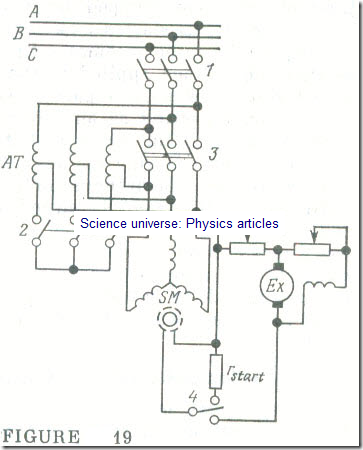Starting of a Synchronous Motor
The resultant torque that a synchronous motor develops due to the interaction of the stator magnetic field with the excited rotor at standstill is zero very nearly. Therefore, for starting, the rotor of a synchronous motor has to be brought up to a nearly synchronous speed in one way or another. Until quite recently this purpose was served by a small induction motor, and the synchronous motor would then be brought in synchronism with the system in the same way as a synchronous generator for parallel operation. That was a very complicated procedure which greatly limited the wide acceptance of synchronous motors. At present, this difficulty is no longer existent a synchronous machine is now started as an induction motor.
For this purpose the pole AT faces of a salient-pole rotor have slots which receive heavy copper or brass bars shorted together at both ends of the rotor, thus forming a squirrelcage structure which occupies only a part of the rotor circumference. In one design of a synchronous motor, there is no starting squirrel-cage structure. Its purpose is served by
the substantial rotor core, the metal wedges embedded in the rotor slots, and the binders insulated electrically from the rotor core.
Starting a synchronous motor by induction-motor action is in two steps. During the first step, induction-motor action brings the synchronous motor to nearly synchronous speed with no d.c. excitation applied. During the second step, the direct field current is turned on and the synchronous motor is caused to pull into synchronism. As a rule, the field winding terminals are shorted through a resistor, rstart (Fig 19) whose resistance is 8-10 times that of the field winding. The field winding ought not to be left open-circuited as the rotating magnetic field might induce in it a heavy emf dangerous to the insulation. Nor would it be well advised to short circuit the field winding as the relatively heavy single-phase current induced in it might retard the rotor once it has come up to half the synchronous speed.
In most cases, synchronous motors are of heavy power ratings, and this necessitate a reduction in their starting current by bringing down their starting voltage. This is often done by connecting the motor to be started to the power system via a starting autotransformer or an inductor. The starting procedure commences by closing switch 2 ( see Fig 19) so that the three phase windings of an autotransformer, AT are connected in a star. Closure of witch 1 applies the line voltage to the input terminals of the autotransformer . In this way, the voltages applied between the stator-winding terminal of a synchronous motor, SM, are the line voltage of the. three-phase system stepped down by the autotransformer. The synchronous motor is tar ted as a squirrel-cage induction motor. When the slip of the rotor becomes sufficiently small, witch 2 is opened, so that the voltage applied to the synchronous motor is somewhat raised since now only a part of ea h phase winding of the autotransformer is acting as an inductor connected in series with the phase winding of the motor and its resistance somewhat limits the starting current. During the next top the full supply-line voltage is applied to the synchronous motor by closing witch 3. However, until the direct current is turned on the rotor keeps rotating a. an induction motor. The starting procedure is completed by applying the direct current to excite the field with the aid of witch 4. The resultant electromagnetic force bring up the motor to the synchronous speed, and the motor develops the required torque. This starting procedure does away with synchronizing and may be readily automated.

